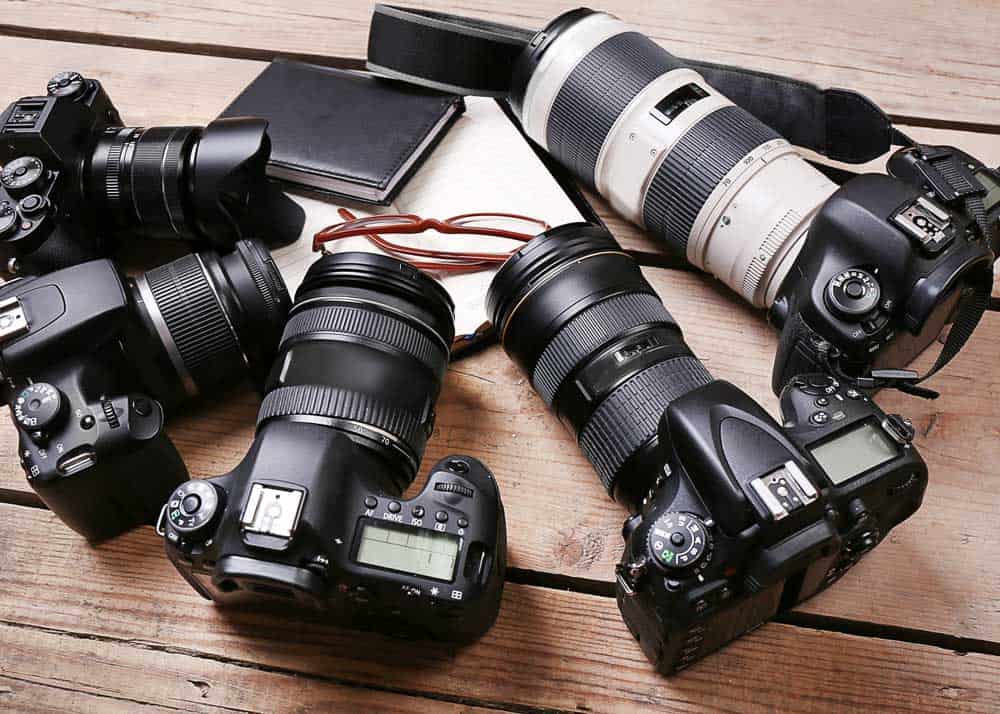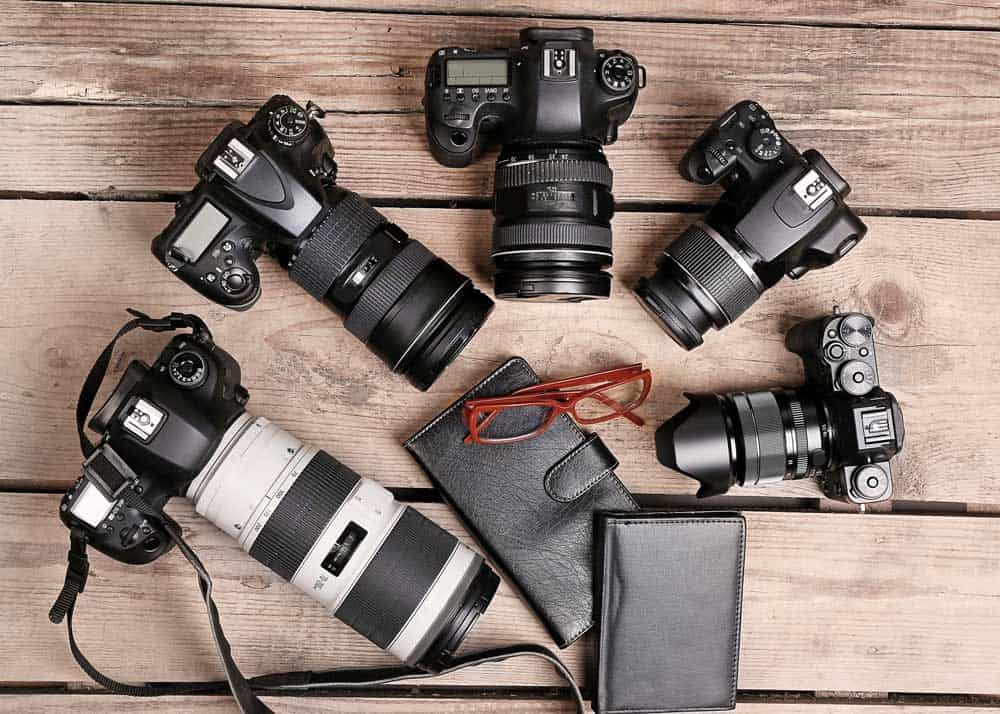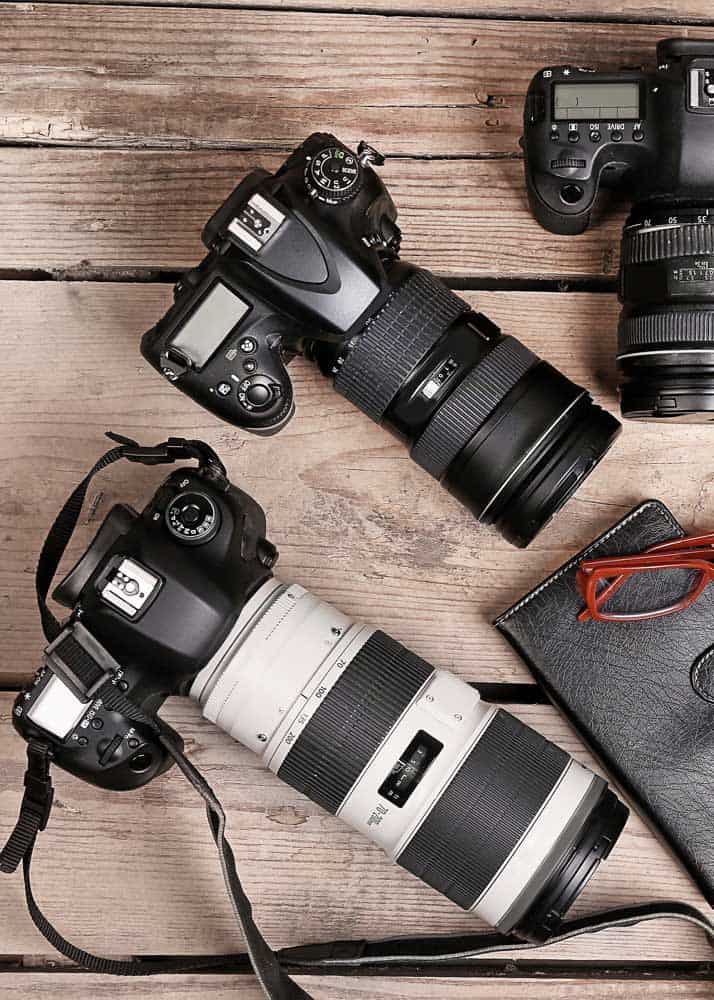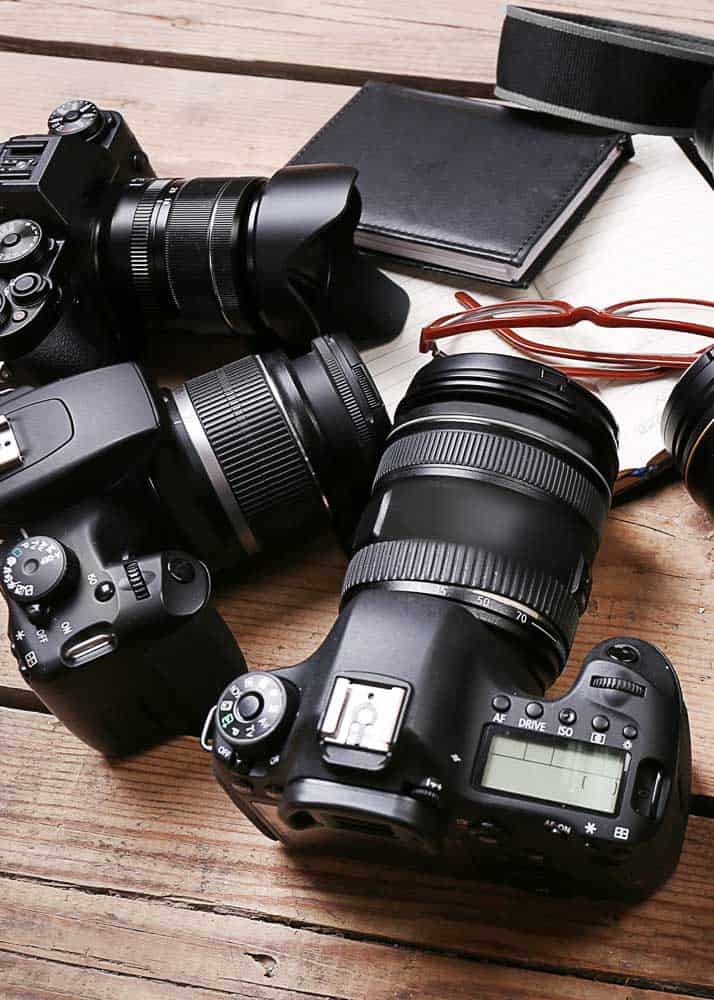New camera? How many megapixels? While this used to be how cameras were compared, it just doesn’t matter anymore. How many megapixels is good for a camera? And how many do you need? In this post, we break down the megapixels required for different print sizes and use online.
12 megapixels is sufficient for almost all consumers and content creators. This allows enough resolution to print a 12″ x 16″ photo. And 12MP is larger than you’ll ever need for online sharing.

How Many Megapixels Do I Need?
To understand megapixel requirements, we break down common aspect ratios, common print sizes, and common sizes for online use. This post will help you know how many megapixels you need to get the print and online results you want.
The following charts show two of the most common aspect ratios. Not sure which aspect ratio your camera uses? Jump to the Aspect Ratio and Common Print Sizes Chart.
How Many Megapixels Chart (Most Cameras: 3:2)
This aspect ratio (3:2) is found in most DSLR, mirrorless, and many point-and-shoot cameras.
Here are the print size and pixel ratios for 5 to 30MP. Print sizes are rounded down to the most common photo print size.
| Megapixels | Best Print Quality 300ppi | Good Print Quality 240ppi | Pixel Resolution | Camera Example |
|---|---|---|---|---|
| 5MP | 6″ x 9″ | 6″ x 9″ | 2741 x 1824 | Security Camera |
| 8MP | 8″ x 12″ | 8″ x 12″ | 3468 x 2307 | Security Camera |
| 12MP | 8″ x 12″ | 10″ x 15″ | 4247 x 2826 | DJI Osmo Pocket |
| 16MP | 10″ x 15″ | 12″ x 18″ | 4904 x 3263 | Trail Camera |
| 18MP | 12″ x 18″ | 12″ x 18″ | 5201 x 3461 | Panasonic Point and Shoot |
| 20MP | 12″ x 18″ | 12″ x 18″ | 5483 x 3648 | GoPro Hero9 |
| 26MP | 12″ x 18″ | 16″ x 24″ | 6251 x 4159 | Canon Mirrorless Camera |
| 30MP | 12″ x 18″ | 16″ x 24″ | 6715 x 4468 | Canon Full Frame DSLR |
The above calculations are based on a 3:2 aspect ratio (nominal format of 1.503:1). This aspect ratio is common with DSLR, mirrorless, and many point-and-shoot cameras, along with vintage 35mm film.
How Many Megapixels Chart (Phones, Other Cameras: 4:3)
This aspect ratio (4:3) is found in GoPro action cameras, most smartphones, and some point-and-shoot cameras.
Here are the print size and pixel ratios for 5 to 30MP. Print sizes are rounded down to the most common photo print size.
| Megapixels | Best Print Quality 300ppi | Good Print Quality 240ppi | Pixel Resolution | Camera Example |
|---|---|---|---|---|
| 5MP | 6″ x 8″ | 6″ x 8″ | 2582 x 1937 | Security Camera |
| 8MP | 6″ x 8″ | 10″ x 13″ | 3266 x 2450 | Security Camera |
| 12MP | 10″ x 13″ | 12″ x 16″ | 4000 x 3000 | DJI Osmo Pocket |
| 16MP | 10″ x 13″ | 12″ x 16″ | 4618 x 3465 | Trail Camera |
| 18MP | 10″ x 13″ | 12″ x 16″ | 4898 x 3675 | Panasonic Point and Shoot |
| 20MP | 12″ x 16″ | 12″ x 16″ | 5163 x 3873 | GoPro Hero9 |
| 26MP | 12″ x 16″ | 18″ x 24″ | 5887 x 4416 | Canon Mirrorless Camera |
| 30MP | 12″ x 16″ | 18″ x 24″ | 6324 x 4744 | Canon Full Frame DSLR |
Calculations are based on a 4:3 aspect ratio (nominal format of 1.333:1). This aspect ratio is common with DSLR and vintage 35mm film.

How much memory do you need? Here’s how many photos and minutes of video per GB of SD card memory.
Common Aspect Ratios and Print Sizes
To help you make sense of the different aspect ratios and print sizes, this chart breaks down common print sizes for each ratio.
Of course, you can print any aspect ratio in any size. But following this chart means you can avoid cropping or adding additional white space.
Likely your camera (from DSLR to smartphone) will have a 3:2 or 4:3 aspect ratio.
| Aspect Ratio | Nominal Aspect Ratio | Common Print Sizes (Inches) |
|---|---|---|
| 1:1 | 1.00 | 5×5″, 8×8″, 10×10″, 12×12″, 16×16″, 20×20″ |
| 3:2 | 1.50 | 4×6″, 6×9″, 8×12″, 10×15″, 12×18″, 16×24″, 20×30″, 24×36″ |
| 4:3 | 1.33 | 6×8″, 9×12″, 10×13″, 12×16″, 18×24″ |
| 16:9 | 1.78 | Not a common print size. Cropping required |
- What’s the most popular aspect ratio? 3:2 is the most common aspect ratio used today. It is found in most DSLR, mirrorless and many point-and-shoot cameras.
- What cameras use 4:3 aspect ratio? The 4:3 aspect ratio is used in GoPro sensors, most smartphones, and some point and shoot cameras.
- What cameras use 16:9 aspect ratio? The 16:9 aspect ratio is used in video and seldom used in photography. The exception is for some action cameras that allow photos to be shot (actually cropped in-camera) to this ratio.
Changing Aspect Ratio in Camera: 4 Brands
Some cameras allow users to change the aspect ratio of the camera. While not every model allows aspect ratio change, these four brands have models that do.
Here’s how to change the aspect ratio in four different camera brands.
- Canon: Navigate to Shooting Menu > Crop/aspect ratio. Here you can choose between several aspect ratios.
- Nikon: Navigate to Photo Shooting Menu > Choose Image Area.
- Sony: Navigate to Shooting Menu > Aspect Ratio.
- GoPro: You can switch between 4:3 and 16:9.

Most Common Photo Print Sizes
The most common photo print size is 5″ x 7″ and 8″ x 10″, according to Etsy sellers and photo printers.
This means a 12MP camera will capture sufficient resolution for a crisp print up to 20″ x 30″.
Of course, the quality of the photo depends on more than just the resolution. You’ll need a decent camera and some basic lighting and composition skills.
But assuming that you possess those required elements, as 12MP camera is the minimum you should be looking for.

What About Printing on a Billboard?
The measurements above are based on framed prints, posters, and signs you would be physically close to. For them to appear crisp, they need the stated resolution.
But for something as large as a billboard, you can enlarge your photo to a massive scale – and as long as it is viewed from a distance (like billboards typically are) you won’t need a massive image.
Your over-enlarged photo will appear crisp even though it would look it when you are standing directly in front of it.
How Many Megapixels Do I Need for Online?
If you only share your photos online, you don’t need to worry about resolution. You can’t buy a camera with too small of a megapixel rating. I recommend choosing at least a 12MP resolution. More on that below.
On this blog, we publish a maximum photo width (or height) of 1200 pixels. So while we usually publish 1200 width and 857 pixels high (5×7 ratio). This comes in at 1MP.
Even if we published a square image of 1200 x 1200 pixels (1×1 ratio), it would still only be a 1.4MP image.
So instead of worrying about image resolution, it’s better to focus on buying a quality camera (and lens, if applicable).
The following image is 1000 pixels wide, although the site only allows it to render at 750 pixels (on desktop). On mobile, it is in the range of 400 pixels wide.

Megapixel Basics
The number of megapixels you need in your camera depends on how you plan to use it, with print size a significant consideration. The larger the print, the more megapixels you will need for a quality image.
In most cases, a 12MP camera will be sufficient for making high-quality digital images and standard prints.
Although more megapixels in your camera is typically not a bad thing don’t be fooled by manufacturers who pump higher megapixel count as proof of a superior camera that commands a higher price.
In most cases, lower-megapixel cameras will be able to capture plenty to suit your needs.
The following breakdown looks at the common types of digital cameras and their typical megapixel count.
Average Megapixels: (DSLR) Cameras
Because DSLR cameras are often used for making prints, these cameras will benefit from having a higher megapixel count.
Average MP for a DSLR camera: 25 megapixels, but higher for many professional cameras.
Average Megapixels: Smartphones
The smartphone is one camera where megapixels likely do not matter all that much. However, when marketing their latest smartphone generation, many manufacturers can snare more customers by selling them a camera with more megapixels.
These images often remain digital and don’t typically need high-megapixel cameras. As most pictures taken with a smartphone will be shared on social media and/or sent back and forth between friends, a camera with basic megapixels should be more than sufficient.
In fact, many people are likely familiar with getting the “image too large” message when trying to email a high-resolution photo digitally, so more megapixels can be frustrating.
The one caveat comes with cropping. If you plan to do a bunch of zooming and editing, you will want a camera with a higher resolution to keep your cropped image from turning out grainy.
Average MP for a smartphone: 12-16 megapixels.
Some smartphones have many more. For example, the Samsung S20 has a 64MP camera, and the Samsung S20 Ultra boasts an overwhelming 108MP camera.
Average Megapixels: Point and Shoot Cameras
While many people are ditching their point-and-shoot cameras and simply using the camera on their phones, some people take many photos they do not want to tie up storage on their phones.
They find taking, storing, and transferring high quantities of photographs easier when working with a point-and-shoot camera’s memory card.
As those point-and-shoot photographers are more likely to order prints than those who work from their phones, the megapixel requirements will be a bit higher.
Average MP for a point-and-shoot camera: Around 20 megapixels.
Average Megapixels: Action Cameras
Megapixels are not one of the most important features of a camera used for action photography. In fact, some action cameras do not actively list their megapixel count, with others only listing “still-frame” resolution.
The most important characteristics of a robust action camera are shutter speed, frame rates, and autofocus. They must also be as light and durable as possible.
As such, the megapixel count differs wildly for action cameras, with some having counts as low as those used in smartphones, with others as high as those in DSLR.
Average MP for an action camera: From 12 to 20 megapixels.
The new GoPro Hero11 Black features the highest megapixel sensor (27MP) of any popular action camera.
Pros & Cons of More Megapixels
While more megapixels make your camera capable of capturing more light and producing higher-resolution images, there are some definite drawbacks to shooting with more megapixels.
As a photographer, you decide how to use your camera before deciding on a megapixel count.
Pros of More Megapixels
The advantages of a high megapixel count come down to producing larger images. As the world is becoming increasingly infatuated with big-screen, high-definition televisions, it only stands to reason that cameras with similar capabilities are the wave of the future.
High-megapixel cameras are beneficial in the following realms:
- Printing large, clear images that are not blurred or distorted
- Cropping images without introducing noise
- Allowing for effective zooming to capture details, such as in online real estate listings
- Down-sizing images to eliminate noise and create a clearer picture from the original
Cons of More Megapixels
While the advantages of using high-megapixel cameras to create large, clear, high-resolution images are numerous, there are some downsides to an increased megapixel count:
- More megapixels create larger file sizes, which can quickly fill the storage space on your computer and take longer to download.
- Some online apps and services may not be able to process extremely high-resolution photos, so you may have to spend significant time downsizing or using images from a different camera.
Here are three ways to connect your camera to your computer.

Want to print your photos wirelessly? Here’s how to connect a Canon printer to WiFi
How Many Megapixels Do I Need?
The number of megapixels you need depends on how you intend to use your camera. As mentioned, your prints’ size is a great way to estimate how much resolution you will need.
A general rule is that a print requires 300 pixels per inch (one megapixel equals 1 million pixels). So an 8 x 10 print would need 2,400 pixels x 3,000 pixels for a total area of 7.2 million pixels, or 7.2-megapixel camera.
A 16 x 20 print would require 4,800 pixels x 6,000 pixels for a total area of 28.8 million pixels, or 28.8 megapixels. So professionals making larger portraits must have a camera with higher megapixels.
Photographs intended solely for an online audience are generally a small file size, meaning that low-megapixel cameras can be used to create high-quality digital images.
For example, many Facebook profile pictures use photos of 1.2 megapixels, so if you plan on using your phone’s camera primarily to post on social media, you should not worry about megapixel count when choosing your camera.

Your Turn
While the number of your megapixel needs will vary based on how you intend to use your camera, with print size a major consideration, any camera of at least 12 megapixels should be suitable for regular use.
While professional photographers will likely want cameras of 20+ megapixels, a 12-megapixel camera will provide high-quality digital pictures and allow you to print every standard print size clearly.
- About the Author
- Latest Posts
Hey, I’m Bryan! I’m a content creator and co-founder of Storyteller Tech.
Experienced GoPro Videographer: I’ve been shooting with GoPro cameras for over 11 years. My first GoPro was the Hero3 Silver, bought for a Galapagos work trip in 2012. Today I own 20+ action cameras, including GoPro, DJI, and Insta360 cameras.
Professional Creator: Dena and I have developed video and content marketing plans for numerous international travel brands. And we also run several content businesses.
Bryan also creates at Storyteller.Travel and is co-founder of Storyteller Media, a Canadian-based publishing company.

frank weir
Tuesday 24th of May 2022
Hi Bryan...this is so helpful for consumers. I've owned lots of cameras and it has been discouraging to see manufacturers pack more and more megapixels on their sensors and market them so people think they MUST pay top dollar and, worse, "upgrade"!
Mastering the camera you have is key. We all know about pros who shot great photos on a film HOLGA or a similar basic digital. I'm experimenting with long zoom cams with small, small sensors. Just bought the classic Canon SX50HS from like 2013 or so for under $150! Still great, still relevant...sure makes a lot more sense than a $1000 body and thousands for a 600mm lens...
They can't handle more than 12 megapixels without more noise at high ISO's and boy are they CHEAP! Some bird photographers have made just stunning photos with these machines because they mastered them and their techniques.You would think they must have used a full frame sensor cam they look so good.
Seems like sensor size is now the new marketing battleground since they've pushed megapixels to their limits. People don't realize how expensive lenses are for full frame cams since those sensors really show whether you have a cheap or expensive lens.
Thanks again for a great discussion that is ALL too rare. Seems commentators rarely advise people to stick with a much more affordable lower megapixel cam with a decent lens, preferably a prime and learn how to use it.
frank weir
Bryan Haines
Thursday 26th of May 2022
Great points, thanks for adding to the discussion.
Bryan
HJ Hether
Sunday 1st of May 2022
Thanks for this informative article. I have an old Canon DSLR @ 8 megapixels and was wondering if it's worth the cost to upgrade to another entry level Canon @ 24 megapixels. Based on your article I think it's worth a $500 investment. (My current Canon is now 17 years old and I'm sure the technology is much improved!)
Thanks again.
Joyce Rollins
Wednesday 16th of June 2021
Question ❔ Curious I have a Nikon CoolPix P530 (given to me) 16 mp zooms to 180mm and a Sony Cyber Shot DSC-H300, 20mp, 32 optic zoom. Why does the Nikon 16mp take better pictures than the Sony 20mp? I take mostly nature pictures.
JAMES COHOON
Friday 5th of March 2021
Hi Bryan, Great article, very helpful. Do you know the Nikon D3500 or the Canon SL2 or T7? Just wondering your thoughts or maybe you've reviewed them on another post. Just looking for input. We're trying to decide on a DSLR in the $500-$600 CDN range. Video quality is not critical. Thanks
Bryan Haines
Monday 8th of March 2021
Hi Jim, I haven't reviewed these units. I don't know Nikon cameras, but I'm confident in the quality of Canon. An entry level DSLR should do fine - especially if you're looking primarily for still photos.